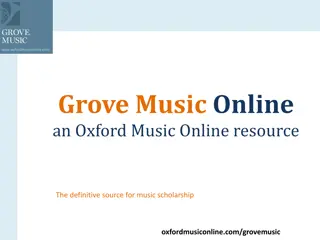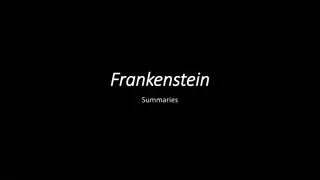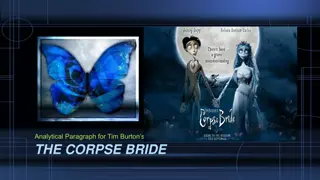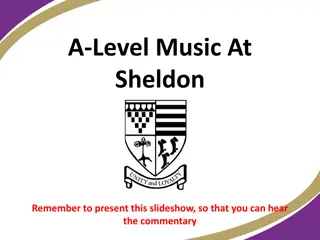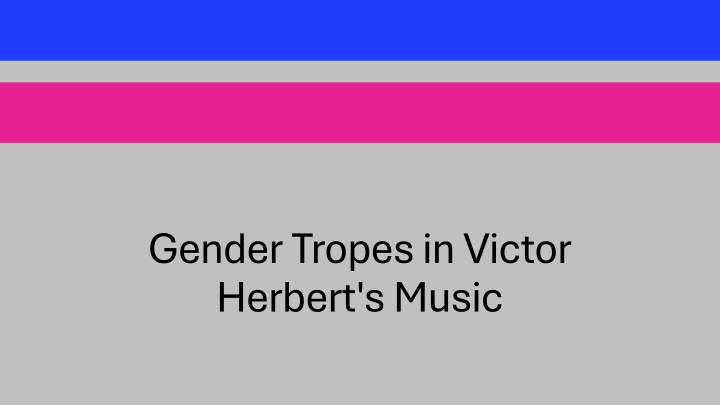
Analyzing Gender Tropes in Victor Herbert's Music and Operettas
Explore the gender tropes portrayed in Victor Herbert's music, focusing on how men and women are depicted as strong, elegant, delicate, and self-sufficient. Examples from operettas like "The Red Mill," "The Fortune Teller," "Babes in Toyland," and "Mlle. Modiste" provide insight into the portrayal of gender roles through vocal melodies and instrumental textures.
Download Presentation

Please find below an Image/Link to download the presentation.
The content on the website is provided AS IS for your information and personal use only. It may not be sold, licensed, or shared on other websites without obtaining consent from the author. If you encounter any issues during the download, it is possible that the publisher has removed the file from their server.
You are allowed to download the files provided on this website for personal or commercial use, subject to the condition that they are used lawfully. All files are the property of their respective owners.
The content on the website is provided AS IS for your information and personal use only. It may not be sold, licensed, or shared on other websites without obtaining consent from the author.
E N D
Presentation Transcript
Gender Tropes in Victor Herbert's Music
Gender Tropes in Media Men are often portrayed as strong, tough, and self- sufficient Women are often portrayed as elegant, weak, overly emotional, and dependent
Victor Herbert's Operettas One of the things that Victor Herbert was known for were his operettas, or light operas. Instrumental selections from his operettas were often used for silent film. Since many of the examples of these tropes are found in the instrumental parts, these tropes would transfer to silent films as well.
"A Widow Has Ways" from The Red Mill The vocal melody and the instrumental part are both very elegant, enforcing the trope that women are always elegant. The song also has a light and delicate feel, which mirrors the trope of delicate women. Finally, the accompaniment often plays the melody with the singer, highlighting the trope that women are dependent. Channel: Bruce Greengart; performed by the Gregg Smith Singers and Lake Placid Sinfonietta; Kimball Wheeler, mezzo-soprano; Carl Eberl, conductor
"Ho! Ye Townsmen" from The Fortune Teller This song has a sparse instrumental texture, which reinforces the trope of self- sufficient men. In the instrumental part that is there, the sound is often very full, which reinforces the trope that men are tough and strong. Channel: VHRP Live! Performance by VHRP Live!
"Barney O'Flynn" from Babes in Toyland The melody of this song is very elegant, again reinforcing the trope of the always elegant woman. The instrumentation and lack of fulness in the orchestra sound reinforce the stereotype of the delicate woman. Channel: SirParsifal; Performed by London Voices and London Sinfonietta; Elizabeth Furtral, soprano; John McGlinn, conductor
"The Time, the Place, and the Girl" from Mlle. Modiste This song opens in a march style, reinforcing the trope of the tough, strong man. The music in the waltz section is much more tender and elegant, seeming to break away from the typical male tropes. However, this song is referring to a woman, so this section is meant to evoke some of the typical female tropes. Channel: BlondieJohnson; Performed by Arthur Rubin; Lehman Engel, conductor
"Naughty Marietta" from Naughty Marietta Even this song, in which a woman is describing not behaving as expected, is mostly light, delicate, and elegant. There are three notable exceptions: on the words "torrid," "bad," "horrid." These words do not fit the stereotypical model woman, so the orchestral parts here do not fit the stereotype either. Brass instruments are used in these spots and harmonies do not sound as nice. Channel: Bruce Greengart; Performed by the New York City Opera; Gianna Rolandi, soprano; John Mauceri, conductor
"If I Were Anybody Else But Me" from Naughty Marietta The contrast between the music for male and female characters can clearly be heard in this duet. While the male character is more conversational at the beginning, the female character is lyrical and elegant. In the stronger section, the orchestral part while the male character is singing is much stronger and bolder. The orchestral part while the female character sings is lighter and more elegant. Channel: Bruce Greengart; Russ Thacker; Gianna Rolandi, soprano; John Mauceri, conductor
References Evolution of Female Characters in Popular Culture ShoutOut! James Madison University Stereotypical Women's Representation in the Film Industry Common Stereotypes of Men in Media | MediaSmarts









